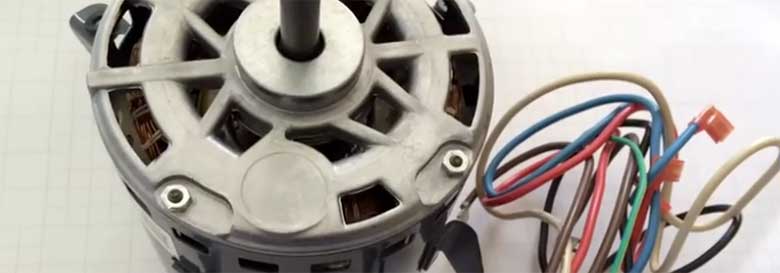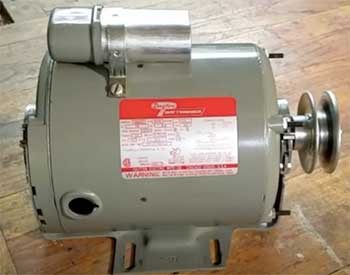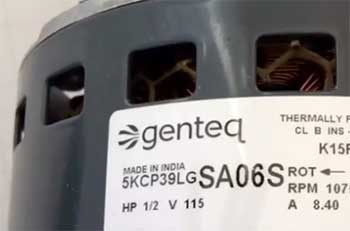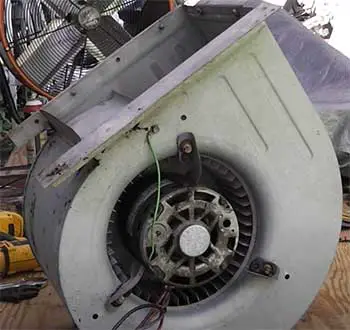The blower motor has to be among the most vital components of an HVAC system. It’s responsible for circulating the outgoing air into your room.
Choosing the right blower motor for your cooling system often means picking the right horsepower. ½ HP and ¾ HP are the most popular options, and chances are you’re confused between these two.
If that’s the case, keep reading our 1/2 HP vs. 3/4 HP blower motor comparison to clear all the confusion!
A Quick Comparison Between Blower Motors
Here are the main differences at a glance, neatly placed in a comparison table for your convenience.
| Specifications | ½ HP Blower Motor | ¾ HP Blower Motor |
| Weight | Up to 16 Pounds | Up to 30 Pounds |
| Power | Basic Power | More Powerful |
| Suitability | Lighter HVAC Duty | Heavier HVAC Duty |
| Noise | Standard | Quiet |
| Cost | Cheaper | Bit More Expensive |
Major Differences Between ½ HP and ¾ HP Blower Motor

We will now dive deeper into the differences that will help you in deciding which horsepower to go for. Without any further ado, let’s get right into them.
- Build Quality
In many instances, you will find the build quality of ¾ HP blower motors to be significantly better than ½ HP units.
That’s simply because ½ HP ones are usually designed to be budget-friendly.
The manufacturers reduce the cost of production by using cheaper materials.
That’s not always the case though, as there are plenty of high-quality ½ HP units built with the best materials available. Those also cost more money to buy.
¾ HP blower motors are designed for more heavy-duty applications, so they need to be built with better quality materials. You will often see this type of motor inside high-end devices.
- Weight
The weight of a blower motor depends on several factors like building materials, motor case length, motor design, etc. ½ HP blower motors tend to be pretty small in size, making them quite lightweight.
You won’t find them going above 16 pounds usually.
¾ HP blower motors, on the other hand, are larger in size, causing them to weigh more. They can be as much as 30 pounds. You can find them in lighter weight as well.
- Energy Efficiency

With motor efficiency mandated by government standards, even baseline affordable blower motors today are reasonably efficient.
However, 3/4 HP motors do rate higher in this area.
They utilize advanced design features like high-efficiency windings and premium bearings to optimize performance.
This translates to greater airflow delivery while using less energy.
On average, a 3/4 HP blower motor may rate around 82-86% efficiency versus 70-80% for a 1/2 HP model.
So in terms of energy conservation, 3/4 HP motors are usually the better environmental choice. Upgrading from an older, inefficient blower to a new high-efficiency 3/4 HP motor can potentially save you 100+ kWh per year.
That said, a 1/2 HP blower can still be a very energy efficient option if selected carefully. Premium models with advanced designs can reach up to 84% efficiency.
For homeowners that simply need a cost-effective residential HVAC blower replacement, they offer a nice balance of performance, energy savings and affordability.
- Suitability
HVAC systems equipped with ½ HP blower motor will perfectly suit average households that aren’t too large. You will see this type of motor inside lighter-duty air-conditioners, furnaces, heaters, etc.
However, when you need a more powerful HVAC system to regulate the temperature in a larger household, you will require the ¾ HP blower motor. Its extra power allows it to handle heavier operations.
- Noise
An area where 1/2 HP motors have an advantage is noise output. As larger motors spin faster with greater torque and airflow, they typically emit higher decibel levels. This may or may not be significant depending on motor design, but it’s something to consider for noise-sensitive applications.
Comparing sound ratings, a typical 3/4 HP blower generates around 60-75 dBA. 1/2 HP blowers range from about 50-65 dBA. Lower dBA levels mean less noise pollution, which can be appreciated in living spaces, classrooms and workplaces.
So if a quiet HVAC system is a priority for you, the 1/2 HP may be preferable.
That said, modern 3/4 HP motors can also run fairly quietly with sound-reduction features like vibration isolators and structural modifications. SoNoise levels shouldn’t necessarily deter you from the 3/4 HP if you need the extra power.
- Cost

As you might expect, 3/4 HP blower motors come with higher price tags given their more powerful capabilities and advanced efficiency designs.
Expect to spend around 15-30% more for a comparable 3/4 HP versus 1/2 HP motor.
For a typical residential HVAC blower replacement, pricing may break down as follows:
• 1/2 HP motor – $150-$250
• 3/4 HP motor – $225-$325
The price difference narrows when comparing premium efficiency models. But overall, the 3/4 HP motors sit at the top end of the price range while 1/2 HP units are most affordable.
Homeowners simply wanting a good-quality, cost-effective replacement for an existing blower often lean toward 1/2 HP units.
Meanwhile, those wanting maximum power plus efficiency and performance may invest extra in the 3/4 HP upgrade. Commercial installations also tend to utilize 3/4 HP models to meet greater airflow demands.
Ideal Applications Compared
In a nutshell:
1/2 HP blower motors offer a nice balance of airflow, efficiency, sound levels and affordability. They are budget-friendly options well suited for most residential HVAC systems from furnaces and air handlers to roof top units. The lower power still meets airflow needs for the average home without being overkill.
3/4 HP blower motors provide premium power and efficiency ratings to handle larger spaces and commercial settings. Upgrade to 3/4 HP if you need to cool/heat bigger zones with maximum airflow. These motors are common across warehouses, schools, hospitals, factories and large office buildings.
Below we’ll explore this more in depth across common motor applications:
- For Furnaces

Furnace blower motors work to circulate warm air through ductwork during heating cycles.
OEM furnaces almost always utilize 1/2 HP blowers, which sufficiently heat most average-sized homes.
Larger 4000+ sq. ft. homes may benefit from upgrading to a 3/4 HP replacement furnace blower.
This bumps up airflow to heat bigger zones.
Just confirm your ductwork can handle the increased output without restriction or leakage issues which could hinder performance.
Also consider your furnace fuel type and output level – a 100,000 BTU high-output gas furnace paired with 3/4 HP blower makes a powerful heating combo. Whereas even the most tricked out 70,000 BTU furnace may not fully leverage a larger blower.
- For Air Handlers
Air handlers team up with heat pumps and air conditioners to cool homes during summer months. Most include 1/2 HP motors out of the box, adequately sized for typical 2-3 ton residential systems (2400 to 3600 sq ft homes).
Larger 5 ton systems found in bigger houses often utilize 3/4 HP air handler blowers. Their extra airflow capacity more comfortably cools spaces 4000+ sq ft. An upgrade here may suit oversized AC systems, allowing them to operate more efficiently without being airflow-starved.
- For Rooftop Units (RTUs)
Commercial RTUs can utilize a wide range of blower motor sizes from fractional to 5+ HP depending on the building’s needs. Small retail stores around 2500 sq ft may use 1/2 HP supply/exhaust fans. Most mid-sized applications up to 10 tons (10,000 to 15,000 sq ft) rely on OEM 3/4 HP blowers. Beyond that, larger RTUs require 1 HP to 1 1⁄2 HP+ motors.
So for commercial rooftop unit blower replacements, consider the building size and tonnage. A good rule of thumb is 1000 CFM per ton of cooling when selecting a properly matched motor.
- For Heat Pumps & AC Condensers
Heat pumps and central air conditioner condenser units circulate refrigerant through a compressor to cool homes. This process generates unwanted hot air as a byproduct inside the cabinet.
So condenser fan motors work to ventilate this hot air outward while pulling cooler ambient air inward across refrigerant coils.
Most residential condenser units under 5 tons utilize cost-effective, single-speed 1/2 HP motors in the 850 to 1150 CFM range. Though upgraded 3/4 HP condenser fan motors are also common in larger 3 to 5 ton systems found on bigger homes. Their airflow boost helps optimize performance.
Variable-speed ECM condenser motors are also available for the highest efficiency. But they carry a high price tag, mainly useful in hot climates or for replacing failed single-speed OEM condensers.
- For Other HVAC Applications
Beyond the main systems above, you’ll also encounter fractional blower motors across other auxiliary HVAC equipment like:
- Air Scrubbers & Negative Air Machines
- Air Curtains
- Fan Coil Units
- Unit Ventilators
- Package Terminal AC Units
- Inline Duct Fans
Here you’ll find 1/2 HP blowers utilized across most residential models and small-capacity commercial units. Three-quarter HP motors often take over in higher-capacity commercial grade equipment where greater airflow is needed meet demands of larger spaces.
Frequently Asked Questions (FAQs)
Let’s read a few frequently asked questions.
Yes, it may be possible to install a larger blower motor in your furnace that packs more power. However, make sure to check your furnace’s amp usage, voltage, and horsepower limitation before installing.
Sure, as long as your device allows it. You can increase the horsepower to a certain extent. However, it may not be possible to decrease horsepower.
Always refer to the manufacturer’s manual before making any changes. You should only change the blower motor if you’re absolutely sure about needing the extra power.
Nowadays, modern blower motors come with tightly sealed bearings and bushings to prevent wear and tear. As a result, they boast a surprisingly long lifespan. You can expect them to run for at least 10 to 20 years.
With time, blower motors will grow weaker and weaker before eventually failing. Poor airflow, strange noises, overheating, excessive energy bills, etc., are telltale signs of failure. When that happens, you should replace the motor to reinvigorate your HVAC system.
Well, the price of a blower motor depends on various factors other than just horsepower. Generally speaking, a ¾ HP unit will be more expensive than a ½ HP one.
Conclusion
The blower motor is often called the heart of an HVAC system. So, you must install a suitable component if you want the most out of your heating and cooling devices.
Hopefully, we’ve been able to drive out your confusion with our in-depth 1/2 HP vs. 3/4 HP blower motor comparison. The differences aren’t enormous, but they are worth considering for sure.
Go for whichever suits your needs the most now that you know all about them!

Thank you for posting this information it was very useful for me I wish you guys luck and keep on posting these kinds of information for us people that don’t know much about electronics etc
I have a 1/2 HP blower motor in my FAU. Can i change it to a 1HP motor? will the 1HP spin faster RPM’s, than the RPM on the 1/2HP?? I want more forced are to come out the residential vent. Right now at 1/2HP…is too weak.